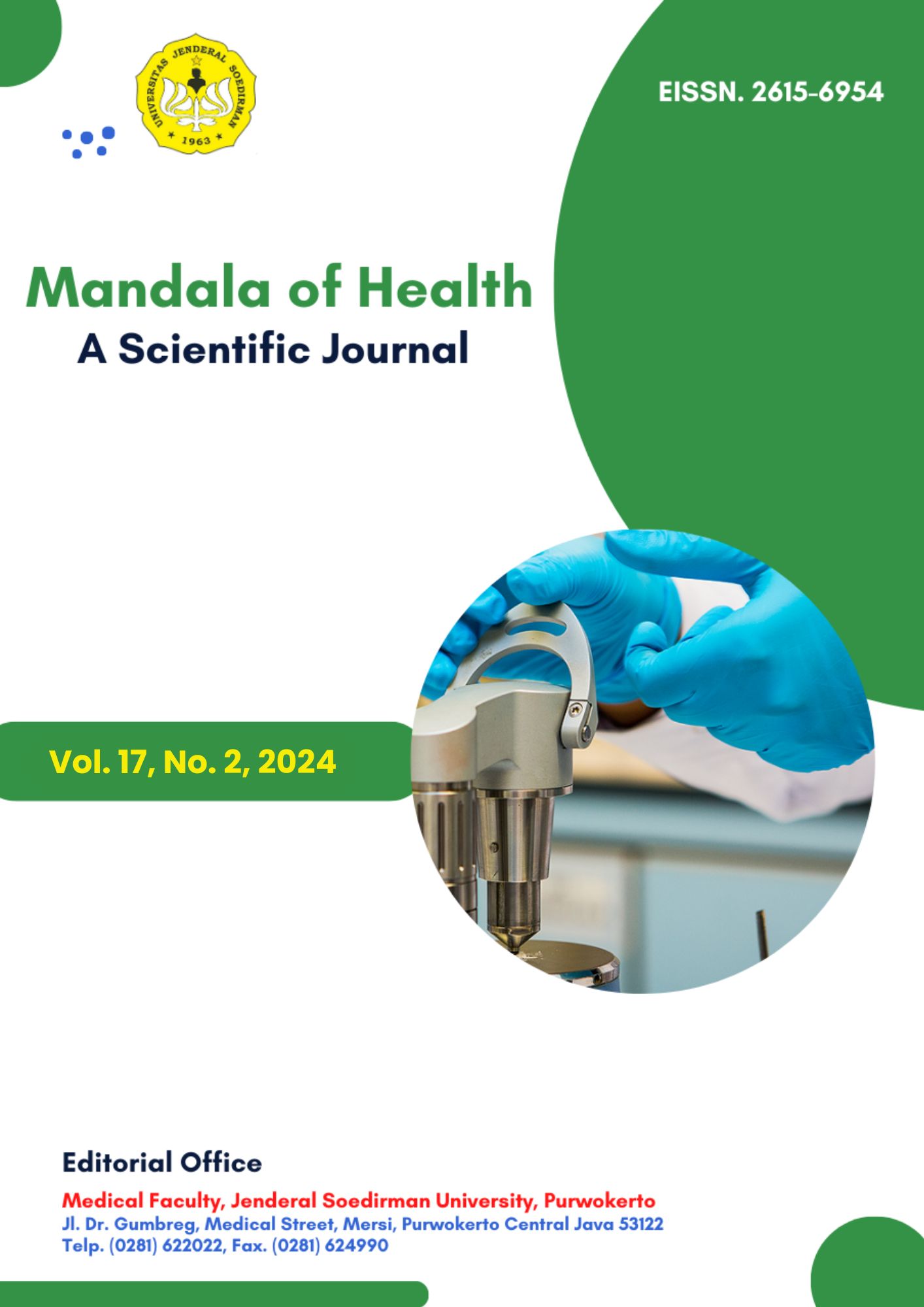HUBUNGAN PENGGUNAAN TABIR SURYA DENGAN KEJADIAN MELASMA PADA PEGAWAI WANITA DI DINAS PERHUBUNGAN KOTA SEMARANG
Abstract
Melasma is hyperpigmentation disorder in form of dark brown irregular macules which thought to caused excessive sun exposure. Regular and correct use of sunscreen is recommended as prevention from UVA and UVB rays, especially for people who have high risk of long-term sun exposure. The purpose of this study was determine the relationship between history of using sunscreen and the incidence of melasma and differences between respondents who used sunscreen compared to respondents who did not use sunscreen on the incidence of melasma. This research is observational analytic study with cross-sectional quantitative approach to female employees at the Semarang City Transportation Office. Obtained 45 samples through total sampling method. Data collection obtained from the anamnesis and respondents' answers through personal data sheets, questionnaires that been distributed and the results of physical examination using wood lamp as well as results of taking photos on the respondent's face which been consulted with dermatologist and genital specialist who met the inclusion and exclusion criteria which then analyzed with SPSS. The results showed that there was significant relationship between history of using sunscreen and incidence of melasma (P<0.05) and there was significant relationship between duration of sun exposure and incidence of melasma (P<0.05). There is significant relationship between history of using sunscreen and incidence of melasma and there is significant difference between respondents who have history of using sunscreen and those who do not have history of using sunscreen with incidence of melasma.
References
Armando A, James ST. Apra S, editors. (2008). Fitzpatrick’s Dermatology in General Medicine. 7th ed. New York: Mc Graw – Hill. P622
Bandem AW. (2013) Analisis pemilihan terapi kelainan kulit hiperpigmentasi RS Husada Utama. Surabaya: Medicinus.
Dahlan, M.S. (2014) Statistik untuk Kedokteran dan Kesehatan : Deskriptif, Bivariat dan Multivariat Dilengkapi Aplikasi Menggunakan SPSS. Edisi 6. Jakarta: Epidemiologi Indonesia.
Djuanda A, Hamzah M, Aisah S. (2013). Ilmu Penyakit Kulit dan Kelamin. Edisi ke 6 Jakarta: Balai Penerbit FKUI.
FDA. (2017). Labelling and effectiveness testing. Geneva. Department of Health and Human Services.
Hilton S, Heise H, Buhren BA, Schrumpf H, Bölke E, Gerber PA. (2013). Treatment of melasma in Caucasian patients using a novel 694-nm Q- switched ruby fractional laser. Eur J Med Res.;18(1).
Hadiyati P, Sebero H, Apriliana E. (2014). Kualitas hidup pada pasien melasma di RSUD Dr. H. Abdul Moeloek Lampung. J Kedokteran Univ. Lampung;3(5):130–8
Hilde L, Barbara B., Sofie De S. (2008). Hypomelanosis and Hypermelanosis. In Wolff K, Goldsmith LA, Katz SI, Gilchrest BA, Paller AS, Leffel DJ, editors, Fitzpatrick dermatology in general medicine. 7th ed. New York : McGraw-Hill,
Ingber A. (2009). Obstetric dermatology. Obstetric Dermatology A Pract Guid.;1–179.
Kartawiguna E. (2021). Dermathologic. Journal Universa Medicina.18(1)
Lyford WH, Elston DM, editor. (2016). Melasma, Medscape eMedicine.
Laperee H, Boone B, Schepper SD et al. (2008). Hypomelanoses and Hypermelanoses. In:
Marianingrum D, . S. (2020). Hubungan lamanya paparan sinar matahari dengan kejadian melasma pada wanita pemulung di tempat pembuangan akhir Telaga Punggur Kota Batam. Zo Kedokteran Program Studi Pendidikan Dr. Univ Batam.;9(3):75–81.
Marliani L, Velayati R, Roni A. (2015). Aktifitas antioksidan dan tabir surya pada ekstrak kulit buah pepaya. Prosiding SNaPP.
Montemarano., (2011). Melasma. http://emedicine.medscape.com/article/1068640-overview
Melyawati, Suseno LS, Bernadette I, Legiawati L. (2014). Perkembangan terbaru etiopatogenesis melasma. Media Dermato-Venereologica Indonesiana.
Park HY. (2012). Biology of melanocytes. In Goldsmith LA. Fitzpatrick, Dermatology in general medicine, Mc Graw Hill, New York.
Pravitasari DN, Setyaningrum T. (2012). Chemical peeling pada melasma. Berk Ilmu Kesehatan Kulit Kelamin;24(1):55–60.
Putri AT. (2020). Faktor Risiko melasma pada petani. J Agromedicine Unila.;7:35–9.
Saputra IB, Dkk. (2021). Hubungan lama paparan radiasi ultraviolet (UV) dengan angka kejadian melasma pada petani. Univ Islam Bandung Repos.;5- 7.
Setyawati N, Indira IGAAE, Puspawati NMD. (2019). Insiden dan profil melasma di Rumah Sakit Umum Pusat Sanglah Denpasar Periode Januari 2014 sampai Desember 2014. E-Jurnal Med.;8(2):1–7.
Sujarweni, V.W. (2014) Metodologi Penelitian. Yogyakarta: Pustaka Baru Press
Steiner D. Feola. (2015). Treatment of Melasma. Systematic review Surg. Cosm. Dermatol.
Svobodova A, Zdarilova A, Maliskova J, Mikulkova H, Walterova D, Psotova J. (2006). Attenuation of UVA-induced oxidative damage to human keratinocytes by silymarin. Free Radic Biol Med (submitted).
Umborowati MA. Rahmadewi. (2014). Studi retrospektif: Diagnosis dan terapi pasien melasma. Journal Unair Berkala Ilmu Kesehatan Kulit dan Kelamin.;26(1): 56-62
WHO. (2008). The Global Burden of Diseases: 2004 Geneva: World Health Organization. 2008.
Waskita T, Walujo A, Ichlas I. (2018). Hubungan antara riwayat pemakaian tabir surya dengan derajat keparahan melasma. Publ Ilm;1(1):1–12.
Yani MS. (2008). Hubungan faktor-faktor resiko terhadap kejadian Melasma pada pekerja penyapu jalan kota medan. Tesus. Program Magister Kesehatan Masyarakat Universitas Udayana.
Zulkarnain AK, Ernawari N, Sukardani NI. (2014). Aktivitas amilum bengkuang sebagai tabir surya pada mencit dan pengaruh kenaikan kadarnya terhadap viskositas sediaan. Trad. Med J.

This work is licensed under a Creative Commons Attribution-NonCommercial-ShareAlike 4.0 International License.







